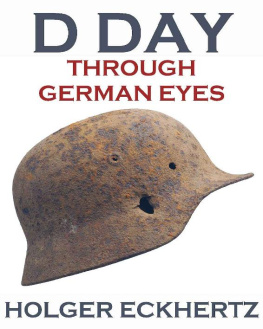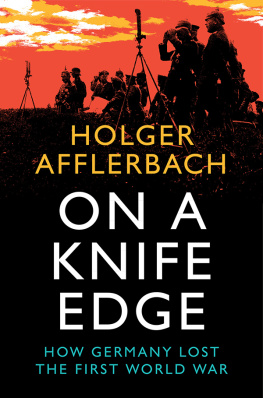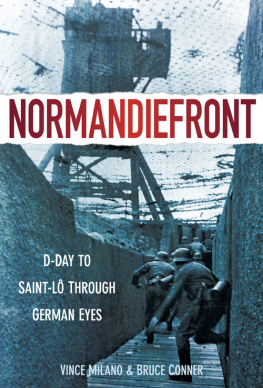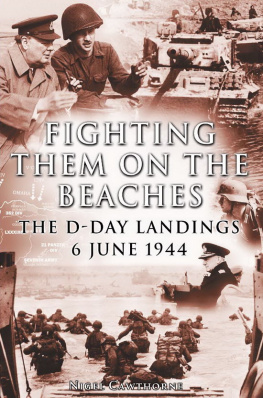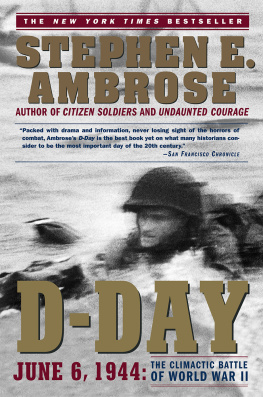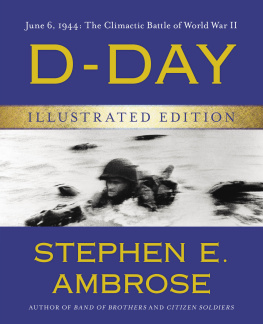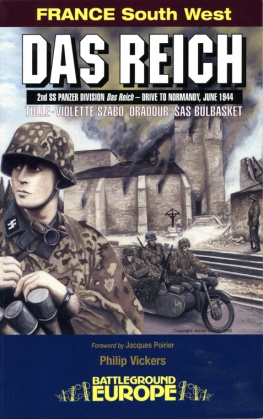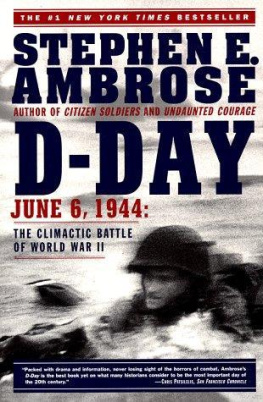Holger Eckhertz [Eckhertz - D DAY Through German Eyes - The Hidden Story of June 6th 1944
Here you can read online Holger Eckhertz [Eckhertz - D DAY Through German Eyes - The Hidden Story of June 6th 1944 full text of the book (entire story) in english for free. Download pdf and epub, get meaning, cover and reviews about this ebook. year: 2015, publisher: DTZ History Publications, genre: Religion. Description of the work, (preface) as well as reviews are available. Best literature library LitArk.com created for fans of good reading and offers a wide selection of genres:
Romance novel
Science fiction
Adventure
Detective
Science
History
Home and family
Prose
Art
Politics
Computer
Non-fiction
Religion
Business
Children
Humor
Choose a favorite category and find really read worthwhile books. Enjoy immersion in the world of imagination, feel the emotions of the characters or learn something new for yourself, make an fascinating discovery.
- Book:D DAY Through German Eyes - The Hidden Story of June 6th 1944
- Author:
- Publisher:DTZ History Publications
- Genre:
- Year:2015
- Rating:3 / 5
- Favourites:Add to favourites
- Your mark:
- 60
- 1
- 2
- 3
- 4
- 5
D DAY Through German Eyes - The Hidden Story of June 6th 1944: summary, description and annotation
We offer to read an annotation, description, summary or preface (depends on what the author of the book "D DAY Through German Eyes - The Hidden Story of June 6th 1944" wrote himself). If you haven't found the necessary information about the book — write in the comments, we will try to find it.
Holger Eckhertz [Eckhertz: author's other books
Who wrote D DAY Through German Eyes - The Hidden Story of June 6th 1944? Find out the surname, the name of the author of the book and a list of all author's works by series.
D DAY Through German Eyes - The Hidden Story of June 6th 1944 — read online for free the complete book (whole text) full work
Below is the text of the book, divided by pages. System saving the place of the last page read, allows you to conveniently read the book "D DAY Through German Eyes - The Hidden Story of June 6th 1944" online for free, without having to search again every time where you left off. Put a bookmark, and you can go to the page where you finished reading at any time.
Font size:
Interval:
Bookmark:
D DAY
Through German Eyes
Eyewitness Accounts by German Soldiers
Of June 6 th 1944
Original Material Edited by
Holger Eckhertz
Copyright Holger Eckhertz 2015
All rights reserved in all languages
Reserved rights include (but are not limited to) translation, excerpt, serialisation, adaption and film. No part of this book may be duplicated, copied, stored or resold by any means without permission.
The publisher wishes to highlight that a number of the following interviews express controversial opinions which originate in the German experience of the Second World War. These opinions are not shared by the current publisher, and the publisher does not condone or promote such views. They are presented in the interests of historical understanding only.
Formatted and Published by DTZ History Publications
Translated by Sprech Media
Audio versions of Books One & Two are available from Audible.com
Contents
This book was not created by me, but by my grandfather, Dieter Eckhertz. In 1944, he held the prestigious role of a military journalist, writing articles and features for German military publications including the magazines Signal and Die Wehrmacht, which were widely read by German troops. Dieter Eckhertz left journalism after the war, but he continued to work on one final project, which was a series of interviews with German soldiers who had fought in Normandy on June 6 th 1944, the day known to the Allies as D Day.
The reason for my grandfathers interest in the German perspective of D Day was simple: shortly before the Normandy landings, he had visited several locations on the Atlantic Wall and interviewed a number of the troops there with a view to writing a feature for Die Wehrmacht magazine. He was fascinated by the enormous preparations being made to defend the Atlantic coast against an invasion launched from England, and by the morale of the troops on the Wall, who were in many cases inexperienced or unfit.
Much later, on the tenth anniversary of D Day in 1954, when many Germans preferred to draw a veil over the events of the war, my grandfather made enormous efforts to track down some of the troops whose units he had visited. He encouraged these men to discuss with him their personal memories of the Atlantic Wall, their frame of mind at the time of the invasion, and their actions during the historic day of June 6 th . His intention was to compile these recollections into a complete book, but the project was still in progress at the time of his death in 1955, and was never completed.
This was the state in which this material eventually came into my hands: as a collection of interviews, notes and verbatim accounts dating from 1954. Some were partial, and some included highly controversial material concerning German forces and French civilians. What comes out of this mix is a highly revealing series of factual accounts by German soldiers who experienced the full might of the Allied onslaught on D Day, especially in the bunkers and 'Resistance Points constructed along the Wall.
I believe that these accounts show a side to the battle that is rarely seen: the motivations of individual German soldiers, their thought processes as the invasion unfolded, and the way they sought to fight back against the Allies in the violent and chaotic hours after the initial landings.
The interviewees did not, of course, think in terms of the Allied code names for the five Normandy invasion beaches (Utah, Omaha, Gold, Juno and Sword, going in order from West to East) but rather in terms of local places or the official designations of their sectors. Nevertheless, I have organised these accounts under the headings of the Allied beach names, as this is how the landings are generally discussed by historians today. I have selected one account for each of the invasion beaches, from Utah to Sword.
Throughout the book, I have included my grandfathers questions and comments in italics, as they were recorded during the discussions. The speakers, like most German people of their generation, use the words England/English interchangeably with Britain/British.
I should emphasise that this book does not give, and is not intended to give, any strategic overview of the landings or any tactical analysis of the engagements described. It gives a voice to several German soldiers experiences of D Day, purely and simply, and I feel that they speak for themselves. My hope is that this book adds to the global understanding of June 6 th 1944, and in a small way serves as a marker to that conflict and its many repercussions.
Holger Eckhertz, July 2015
***
Stefan Heinevez was a Gefreiter (Private First Class) with the 919 th Grenadier Regiment, 709 th Static Infantry Division, based on the Cotentin Peninsula.
Herr Heinevez, I visited the Atlantic Wall in May 1944, and I met some of the men in your regiment.
I think I remember some of the men talking about your visit. You interviewed several of the troops, and asked them about their hopes and sentiments and so on. The men said that you were impressed with the situation in France.
Indeed I was impressed. What about you, how did you feel about your posting to the Atlantic Wall?
In many ways, I was pleased with the posting. You see, my brothers and friends had been on the Russian front, and they had terrible stories of the conditions there. Many men returned without fingers or eyelids because of the frostbite. By contrast, a posting to France was renowned as a comfortable ride. I myself had been in Sicily in 1943, aged nineteen, fighting the Americans, and I was wounded there. This left me with a permanent limp, and for this reason I was sent to the Atlantic Wall.
Were many of the Atlantic Wall troops sent there for similar reasons?
A large number, I think, although I do not know the exact proportion. I think it was at least half of us. But of course, operating chiefly from inside bunkers and other fixed defences does not require a high level of fitness, as the activity is static; for this reason, Herr Eckhertz, people must not think that we were second rate troops. I myself was a formidable operator of my Ringstellung (Ring Position or Tobruk bunker ).
Can you give an explanation of what the Ringstellung or Tobruk was?
Yes, the Tobruk was a widely-used type of small bunker for local defence; this was essentially a concrete casing set into the ground, with a concrete cupola emerging at ground level, allowing a single soldier to fire a machine gun, with only his head and shoulders showing above the ground.
The designs of the Tobruks varied, but most types I saw had a concrete box about three metres square and two metres high, dug in below ground level; the cupola was a circular opening with a concrete rim for mounting the gun. My particular Tobruk had a metal shield on the gun mount, protecting the gunner. These Tobruks were sited around larger bunkers or at significant points in the zone to be defended, sometimes they were placed almost at random in the countryside as a way of making any enemy advance unpredictable in its progress.
These Tobruks were built mostly by prisoners in the construction brigades, who would dig the hole and pour the concrete under the supervision of engineers. Some Tobruks were also brought in as prefabricated boxes and placed in the ground like that. I saw some larger types of the installation which had a small panzer turret on top instead of the cupola. In these cases, the turrets came from old French or Czech tanks, and were traversed with a hand crank, having a crew of two men. But the single-man, MG armed Tobruk was the most common style that I saw.
What was the underground concrete box used for?
Font size:
Interval:
Bookmark:
Similar books «D DAY Through German Eyes - The Hidden Story of June 6th 1944»
Look at similar books to D DAY Through German Eyes - The Hidden Story of June 6th 1944. We have selected literature similar in name and meaning in the hope of providing readers with more options to find new, interesting, not yet read works.
Discussion, reviews of the book D DAY Through German Eyes - The Hidden Story of June 6th 1944 and just readers' own opinions. Leave your comments, write what you think about the work, its meaning or the main characters. Specify what exactly you liked and what you didn't like, and why you think so.

